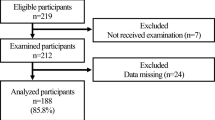Abstract
The purpose of this study was to analyze the relationship between jaw stability and the feeding function of 53 bedridden elderly dysphagic patients. Investigations included a questionnaire on daily life activities and meals, oral examinations, functional tests for feeding ability, and assessments of feeding function during the meal. The results of intraoral examination of this patient population for jaw stability revealed that 34.0% of individuals had posterior support for occlusion regardless of whether they had natural teeth or dentures. Thus, the number classified as having mandibular stability (ST) was 18 and that with no mandibular stability (NST) was 35. In a Repetitive Saliva Swallowing Test (RSST), 83.3% of the NST group and 40.0% of the ST group were unable to swallow more than 3 times within 30 seconds. In a water swallowing test, 91.4% of the NST of group was unable to swallow 15 mL of water by a single swallow, while 40.0% of ST group was capable. The results suggest that jaw stabilization by occlusion with the posterior teeth or dental prosthetics is important to feeding function, particularly swallowing.
Similar content being viewed by others
Author information
Authors and Affiliations
Rights and permissions
About this article
Cite this article
Tamura, F., Mizukami, M., Ayano, R. et al. Analysis of Feeding Function and Jaw Stability in Bedridden Elderly . Dysphagia 17, 235–241 (2002). https://doi.org/10.1007/s00455-002-0063-6
Published:
Issue Date:
DOI: https://doi.org/10.1007/s00455-002-0063-6




